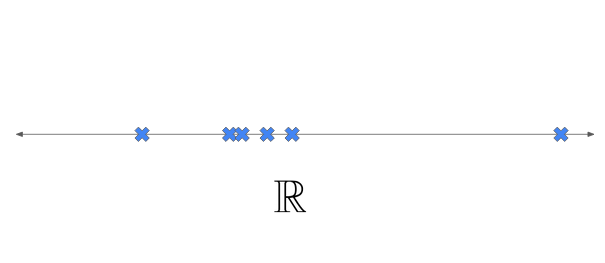Rylan Schaeffer

Resume
Research
Learning
Blog
Teaching
Jokes
Kernel Papers
Leverage (Statistics)
Leverage describes the influence a particular datum has over the linear parameters when fitting a linear regression model.
Intuition
Suppose we will fit a linear model to predict \(y\) using \(x\), where \(x \in \mathbb{R}\). Before even seeing the target \(y\) values, looking at the below data, which datum will likely have the greatest influence over the line of best fit?

Intuitively, the datum furthest to the right. If its corresponding target is a large positive number, the line will probably slope up, whereas if its corresponding target is a large negative number, the line will probably slope down.
Hat Matrix
We know that the optimal parameters will be given by
\[\beta := (X^T X)^{-1} X^T Y\]and thus the predictions will be given by
\[\hat{Y} := X \beta = X (X^T X)^{-1} X^T Y\]The matrix \(H := X (X^T X)^{-1} X^T \in \mathbb{R}^{N \times N}\) is called the hat matrix because it places a hat on \(Y\). The leverages of each datum are given by the diagonal elements of the hat matrix.
Dual Form
The previous definition of the hat matrix \(H := X (X^T X)^{-1} X^T\) is sometimes called the primal form. By the Push-Through Identity, the hat matrix can also be written in the dual form \(H := X X^T (X X^T)^{-1}\)
Properties
Let \(h_i := [H]_{ii}\) be the leverage score of the \(i\)th datum.
-
\(H = H^T\) i.e. \(H\) is symmetric.
-
\(H = H^2\) i.e. \(H\) is idempotent. Proof: We know that \(H^2 = H H = X (X^T X)^{-1} X^T X (X^T X)^{-1} X^T = H\).
-
\(0 \leq h_i \leq 1\). Proof: Because \(H\) is idempotent, we know that \([H]_{ii} = [H^2]_{ii} \Rightarrow h_i = \sum_{n} H_{ij} H_{ji} = h_i^2 + \sum_{j \neq i} h_{ij}^2\). Since \(\sum_{j \neq i} h_{ij}^2 \geq 0\), we know that \(h_i \geq h_i^2 \Rightarrow h_i \leq 1\).
-
The sum of the leverages is equal to the number of parameters, which is also equal to the dimensionality of the data. Proof: